
Moscopole or Voskopoja is a village in Korçë County in southeastern Albania. During the 18th century, it was the cultural and commercial center of the Aromanians. At its peak, in the mid 18th century, it hosted the first printing house in the Ottoman Balkans outside Constantinople, educational institutions and numerous churches. It became a leading center of Greek culture but also with elements of Albanian and Aromanian culture, all with great influence from Western civilization.
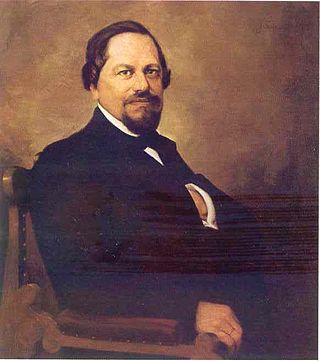
Simon von Sina or Simon Sinas was an Austrian-Greek banker, aristocrat, benefactor and diplomat. He was one of the most important benefactors of the Greek nation together with his father Georgios Sinas.
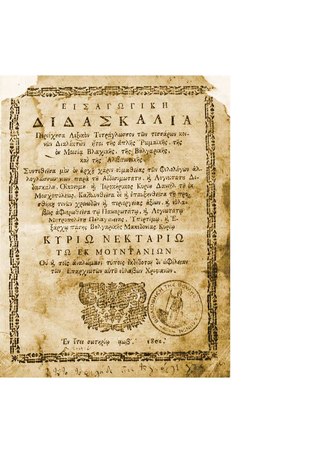
Daniel of Moscopole or Daniil of Moscopole, also known as Mihali Adami Hagi, was an Aromanian scholar from Moscopole and student of Theodoros Kavalliotis, an 18th/19th-century professor and director of New Academy of Moscopole.
Vithkuq is a village and a former municipality in the Korçë County, southeastern Albania. At the 2015 local government reform it became a subdivision of the municipality Korçë. The population at the 2011 census was 1,519. The municipal unit consists of the villages Vithkuq, Leshnje, Gjanc, Lubonjë, Rehovë, Roshanj, Trebickë, Grabockë, Treskë, Stratobërdh, Panarit, Shtyllë and Cemericë.
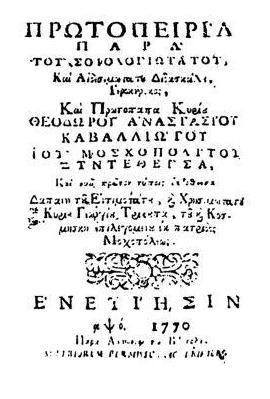
Theodore Anastasios Kavalliotis was a Greek Orthodox priest, teacher and a figure of the Greek Enlightenment. He is also known for having drafted an Aromanian–Greek–Albanian dictionary.

Eulogios Kourilas Lauriotes (1880–1961) was a bishop of the Orthodox Autocephalous Church of Albania. He was the Orthodox metropolitan bishop of Korçë (Korytsa) in Albania between 1937 and 1939, and a professor of philosophy and author on religious matters. He later became one of the leaders of the Northern Epirus movement, propagating that Greece should annex southern Albania.
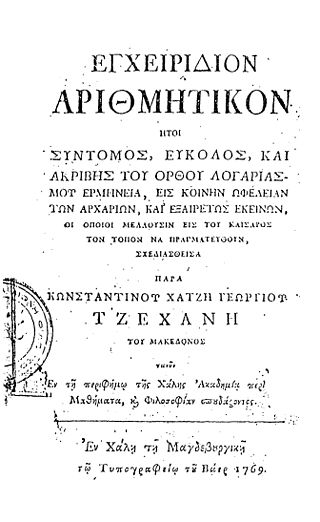
Konstantinos Tzechanis was a philosopher, mathematician and poet from the 18th century Aromanian center of Moscopole.
Ioannis Chalkeus or Chalkias, was an Aromanian scholar, philosopher and figure of the modern Greek Enlightenment.
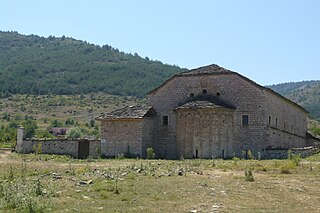
The St. Michael Church (Albanian: Kisha e Shën Mëhillit or Kisha Kryeengjëjt Mihail dhe Gavriil, also known as Church of the Archangels Michael and Gabriel is an Orthodox church in Moscopole, modern southeastern Albania.
Theophrastos Georgiadis was a Greek author and teacher. His work about the once prosperous urban center of Moscopole, today a small mountain village in southeastern Albania, is considered of great value since it concerns the period before the town's destruction in 1916.

Ilo Mitkë Qafzezi was a prolific Albanian scholar and writer of historical and religious subjects. He is known as the translator of the Koran into Albanian in 1921.

Gregory of Durrës was an Albanian scholar, printer, typographer, teacher, and Eastern Orthodox Christian monk and cleric of Ottoman Albania who is thought to have invented a particular Albanian alphabetic script, the Elbasan script, used to write the Elbasan Gospel Manuscript. The manuscript is one of the oldest known pieces of Albanian Orthodox literature, as well as the oldest known Orthodox Bible translation into Albanian.
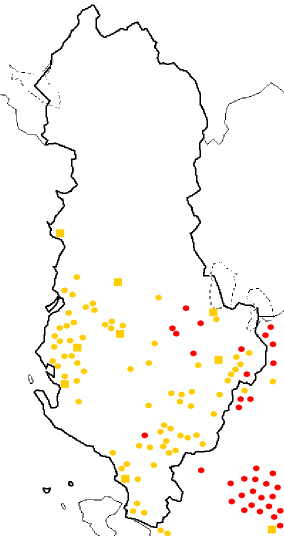
The Aromanians in Albania are an officially recognised ethnic minority in Albania.

Maximilian Demeter Peyfuss, was an Austrian historian, translator and writer.
Constantin Ucuta was an Aromanian academic and protopope. He was born in Moscopole, an economically powerful city and Aromanian centre at the time then part of the Ottoman Empire and now part of Albania. He migrated to Posen, in Prussia, and entered in contact with the small Aromanian community in the city, mostly composed by merchants. He became an academic and a protopope, serving in a church in Posen most likely erected by the typically Eastern Orthodox Aromanian merchants of the city. Other details about Ucuta's biography are scarce and poorly known.
The Aromanian Missal is an anonymous Aromanian-language instructive liturgical book (missal) variously referred to as dating from the beginning, the first half, the middle and the second half of the 18th century. It is the first extensive text in Aromanian, and includes translations of sermons and other religious texts into Aromanian. The Aromanian Missal is believed to have been written in Moscopole, once a prosperous Aromanian city, and uses the Greek alphabet due to archaic forms of Greek being considered the appropriate language for high and literary functions in those times within the Balkans. In recent times, the text of the liturgy has begun to circulate more actively among the Aromanians in Albania with support from the Aromanian diaspora. In a 2002 study on the Aromanians, German researcher Thede Kahl stated that priest Thoma sang this Aromanian-language liturgy at the St. Nicholas Church of Moscopole.
The Moscopole printing house was an 18th-century printing house founded in Moscopole, formerly a prosperous city in the Ottoman Empire and now a village in Albania.
The Codex Dimonie is a collection of Aromanian-language biblical and religious texts translated from Greek. It represents the most comprehensive collection of early Aromanian texts known to date, comprising 127 loose sheets, which were probably bound in the past. The Codex Dimonie was discovered by Gustav Weigand, who subsequently published it, in 1889 in the house of the brothers Iancu and Mihail Dimonie in Ohrid, then in the Ottoman Empire and now in North Macedonia.

Aromanian literature is literature written in the Aromanian language. The first authors to write in Aromanian appeared during the second half of the 18th century in the metropolis of Moscopole, with a true cultured literature in Aromanian being born in the 19th and early 20th centuries. Notable authors include Constantin Belimace, author of the well-known anthem of the Aromanians Dimãndarea pãrinteascã ; Nuși Tulliu, whose novel Mirmintsã fãrã crutsi was the first in Aromanian; and Leon Boga, whose 150-sonnets epic poem Voshopolea ("Moscopole") founded the Aromanian literary trend of the utopian Moscopole. In theatre, Toma Enache has excelled.













